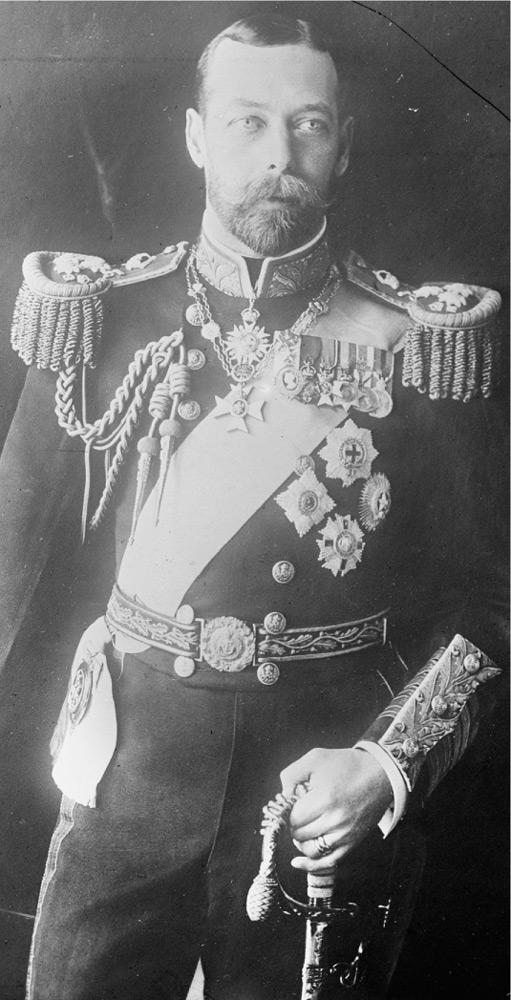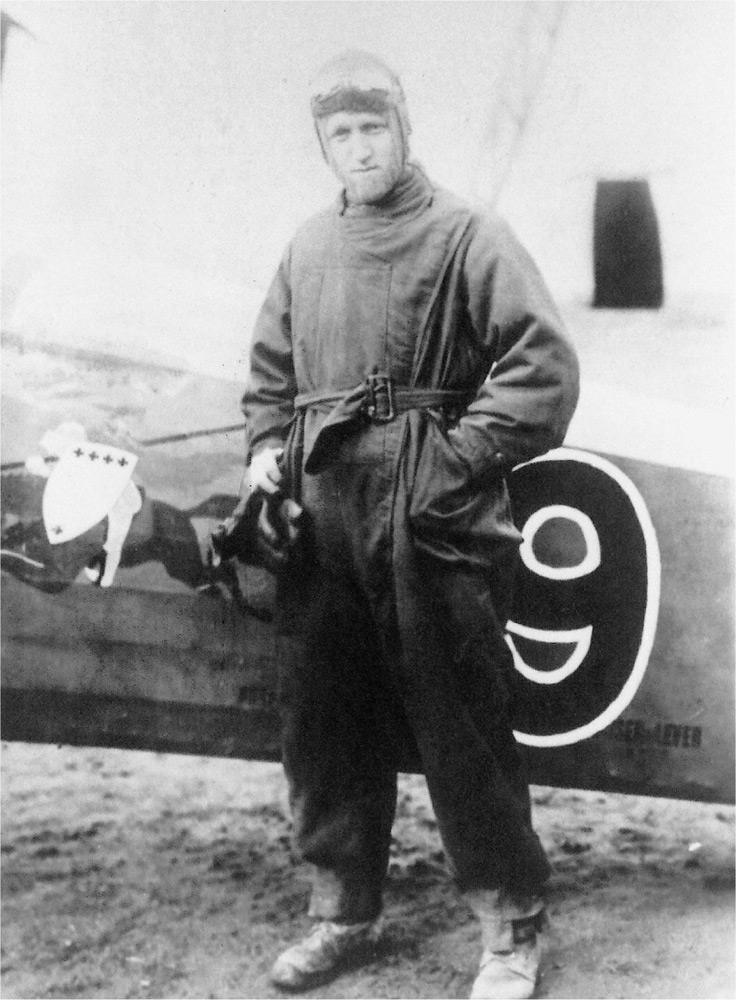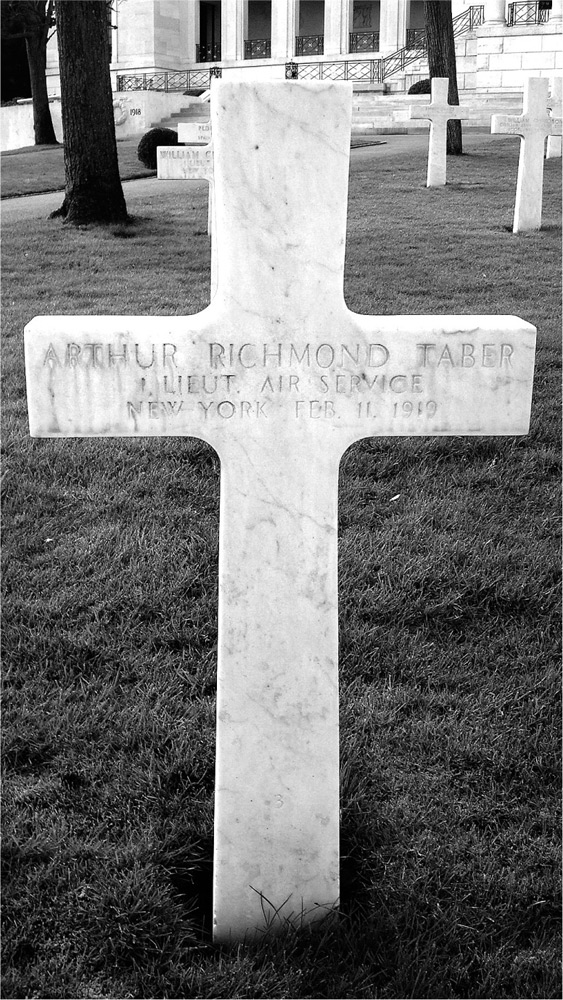
Fred Libby and John Donaldson both received decorations from King George V. Library of Congress
Homecoming
A surprise arrived for 32 Squadron a couple of days after the Armistice—a visit from John Donaldson. The last anyone had seen of the young ace from North Dakota, he was spinning down to the ground on September 1. Now he was splashed all over the newspapers, describing how the Germans took him to a temporary prison camp in the village of Conde, where he shared a cell with another captured American pilot, Lt. Oscar Mandel. The pair jumped from a second floor window and made their way to the nearest German airfield, where they examined the aircraft and picked out a two-seater observation machine to fly back to their lines. “At dawn we got the plane in shape to fly,” Donaldson told the papers. “Just then a German mechanic approached and discovered us. He raised hell. We grabbed him and in the tussle he stabbed me in the back. Mandel put him out of commission by hitting him over the head with a flashlight. Then we ran for it.”
The two Americans were subsequently recaptured, but, on September 26, they were at it again, absconding from their new prison in the town of Valenciennes by cutting a hole in the roof of their cell with a piece of broken saw that they had stolen. Five men escaped in total but they soon decided to split up to improve their chances of making it to the Dutch border. On October 14, Donaldson and two of his companions, a pair of American pilots—Theose Tillinghast and Robert Anderson—reached the frontier between Belgium and Holland. “We spent a week reconnoitering to find a place to cross,” explained Donaldson. “This was hard because there was an electric wire barrier charged with 3,000 volts. Finally we discovered an opening and crawled for fours on our bellies making all of 100 yards. Then we waited until the German sentries were far apart, stood up and ran like hell to Holland, which was half a mile away. We heard a yell and a shot but did not stop.”40
Rogers told his fiancée he “never liked the chap personally and still don’t,” but it was a fine effort and Donaldson deserved the praise he was getting.

Fred Libby and John Donaldson both received decorations from King George V. Library of Congress
There was a crushing sense of anti-climax to life in the squadron post-war. Rogers felt no affinity to the new faces in the mess, the young pilots who had come out in the last weeks of the war. A chasm separated their experiences from his own. “Nearly half the flying officers haven’t been over the line more than two or three times,” he wrote home. “When you’ve been thru the mill with fellows, been in all sorts of tight places where you’ve helped them and they’ve helped you, there is a mutual feeling that isn’t possible with fellows who’ve come out just about as the war ended.”
On November 21, Rogers, Frank Hale, and another officer went in search of Alvin Callender’s grave. They’d tried a week earlier, with no success, but this time they found it. The wreckage of his S.E.5 still lay on the ground, a few hundred yards from a cluster of houses. The three airmen sifted through the twisted fragments of metal with professional interest, theorizing about what must have happened. They were shocked by the number of bullet holes: “the machine had simply been shot to pieces,” wrote Rogers.
A local farmer guided them to where Callender lay, close to his farmhouse. Rogers was upset that the grave was unmarked so “we put up the cross and then sodded the top and built a little border of bricks around the edges.” One of the officers took a photograph of Rogers beside the cross: something to send to Callender’s family. They removed their caps, bowed their heads, and stood for a few moments in silence. “It was a solemn party that came home,” he told his fiancée.
Rogers, recently promoted to captain, left France on leave on December 3, relieved to be rid of the graves and memories of friends, and glad also to be free of a squadron ravaged by influenza. In all, thirty members of thirty-two had been hospitalized on account of the pandemic sweeping the world, but only one man had died. Not so in England, Rogers wrote his girlfriend, where “there have been 32,000 deaths…in six weeks.”
Rogers was back with the squadron just before Christmas. Still no definite news on when he might return to the States, and to her, he told his fiancée on December 26. They had received a lecture on demobilization and “things looks very encouraging.” Fingers crossed repatriation would begin in early February.
New Year’s Eve 1918 was a “quiet affair” at 32 Squadron. They were invited to a dance at another aerodrome, but most of the officers present were fresh out from England. There was no bond. Rogers and a few of the old hands returned to their mess, “made some rum punch, and sat in front of the fire until about four just talking.”
Elliott Springs saw in the new year in Tours, central France, where the 2nd Aviation Instruction Center was based, at a ball attended by Gen. James G. Harbord, formerly General Pershing’s chief of staff until, at the end of the war, he was assigned to take charge of troop and supply movement. There were plenty of junior officers in attendance, most fresh out from the States, the creases in their pants still razor sharp. They “bawl hell out of me on all occasions,” wrote Springs in a letter to his stepmother on January 1. “I suppose I ought to feel lucky if these brave soldiers don’t court-martial me.”
Springs laughed at the Johnny-Come-Latelys. They could bawl as much as they liked. Usually they then pointed a dismissive finger at the small ribbon beneath his wings of diagonal stripes of white and deep purple and asked what it was.
“It’s British,” replied Springs more than once.
“Is it for service in a certain campaign?”
“No.”
“Then it’s for valor?”
“It’s the DFC.”
“Did you get it for getting a Hun?”
“No.”
“What’s it for, then?”
“They sometimes give it to people who get more than five.”
Springs had finished the war with sixteen victories, and another decoration, the DSC, awarded for his “extraordinary heroism” of August 22 when he shot down three Fokker D.VIIs in the space of a few hours. Springs only learned of the award on December 31; by then he’d long since lost interest in the baubles of war. “They gave me a blank to full in,” he told his stepmother. “Did I desire to remain in the regular army, reserve corps or get immediate and complete separation?” He chose the latter. “I’m coming home. I may be gray and tattered but I’m on my way.”
He reckoned he’d be back in February. Until then he’d make the best of a bad job. Trips to Paris, and jaunts to Issoudun to see Larry Callahan and Bim Oliver, “who have been sitting around in the mud for six weeks.”
George Vaughn had also been stuck in the mud of Issoudun for longer than he cared to remember. On November 25 he, Callahan, and Oliver—“three fellows who had been at the front the longest”—were ordered to the 3rd Aviation Instruction Center at Issoudun. Vaughn’s hopes soared that he was on his way home. First in, first out. But no. “When we arrived here they told us we were to go through a very thorough physical examination to determine the effects of the war on the pilots who have survived it,” he wrote his parents on November 28. “We spent the whole day yesterday in the hands of the ‘Medical Research Board,’ as they call it, and they are not through yet.” It was a waste of time in his opinion, Vaughn told his parents. He was A-OK. “So I am afraid they have not learned much from their experiments on us.”
Reunited and restless, Vaughn, Callahan, and Oliver sought distractions wherever possible at Issoudun. The center had a large Y.M.C.A. building and a Red Cross Hut, inside which air crew whiled away time, drinking and chatting and flirting with the female staff. Arthur Taber, also back at Issoudun looked on in disgust. “It is such a distasteful way in which to celebrate what might be called your ‘deliverance from death’ at the front,” he wrote his mother on November 26. “I can’t see why every educated man…shouldn’t prefer to seek a church instead of a bar in which to express his feelings of gratitude.”
Vaughn disagreed. On December 15, he was still languishing at Issoudun, still in the dark as to when he might return home. “Life is so slow around here that there is really not very much to write about,” he told his parents. “The only pleasure we have is over at the Red Cross Hut, where it is quite comfortable, and there are some very nice girls, good meals, and a piano.”
Vaughn closed his letter with a P.S—“Perhaps home by New Years yet!”
But he wasn’t. He ate his Christmas dinner in the Red Cross Hut—the women dolling out cigarettes and candy to the officers—and spent New Year’s Eve also at Issoudun. On January 12, he was in Angers, approximately 190 miles south-west of Paris, en route to the Atlantic port of Nantes. He was with Reed Landis, and in a quick letter to his parents he wrote, “I don’t think we will have to wait long there. All the waiting is done.”
George Vaughn and Reed Landis reached New York on February 3, 1919, on board the USS Agamemnon. Formerly the Kaiser Wilhelm II, a German passenger steamer completed in the spring of 1903, the Agamemnon began bringing American service personnel home from France in December 1918. In nine months she made nine voyages, ferrying nearly forty-two thousand soldiers and airmen back to the States.
Three days earlier America’s “Ace of Aces,” Eddie Rickenbacker, had arrived home to a tumultuous reception. All of his credited twenty-six victories had been achieved with the 94th Aero Squadron, the “Hat-in-the-Ring” boys, an American unit in the American air force. Thousands cheered Rickenbacker as he strolled down the gangplank of the White Star liner Adriatic; he was the all-American hero, whose portrait had adorned scores of newspapers a fortnight earlier when the War Department released the names of sixty-three American aces. All deserved credit but Rickenbacker was the “Ace of Aces.”
Rickenbacker was whisked off to New York’s Waldorf-Astoria where he was the guest of honor at a dinner hosted by the Automobile Association of America. Newton Baker, secretary of war, was the guest speaker, and privileged he was, too, to shake the hand of America’s most famous airman.

Eddie Rickenbacker, America’s “aces of aces,” achieved twenty-six victories with the 94th Aero Squadron.

Painted on this fuselage is a knight on his charger chasing the devil, the insignia of the 91st Squadron.
There was a small crowd waiting for the Agamemnon, including a reporter from the New York Tribune. Word had got out that the son of Judge Kenesaw Landis was on board, “second only to Captain Eddie Rickenbacker with a score of twelve.” The paper mentioned in passing that Vaughn had shot down ten enemy aircraft—in fact he had thirteen victories—but the reporter was really interested only in Landis. Unfortunately “it was difficult to make him talk,” the reporter told his readers the next day. “When asked if he were not one of our foremost pilots, he said he had not done any more than twenty or thirty other fellows, and only did what he was trained and paid to do.”
Landis eventually fed the journalist a few tidbits about dogfights and narrow escapes. Vaughn took his chance and slipped away without saying a word. He had spotted his parents; he had come home.
Arthur Taber was still in France in February. On the second day of the month he wrote his parents from the American base at Orly airfield, a few miles south of Paris. He continued to ferry aircraft hither and thither, although he admitted that “it seems strange indeed to be still writing from France with hostilities ended and everyone bending every effort to get home; it seems as if one should at least be on the water, if not already at home.”
On February 11, Taber took an aircraft for a test flight around Paris. Shortly after taking off from Orly the machine crashed to the ground. Taber “was killed instantly and suffered no pain.”

Arthur Taber is buried in the Suresnes American Cemetery on the outskirts of Paris. Gavin Mortimer
Taber’s death was listed in the Washington Times on March 5, 1919, one of 340 servicemen to have died in recent weeks from illness or accident. The paper noted that the latest figures raised to 271, 462 the number of casualties suffered by the United States in the War to end all Wars.